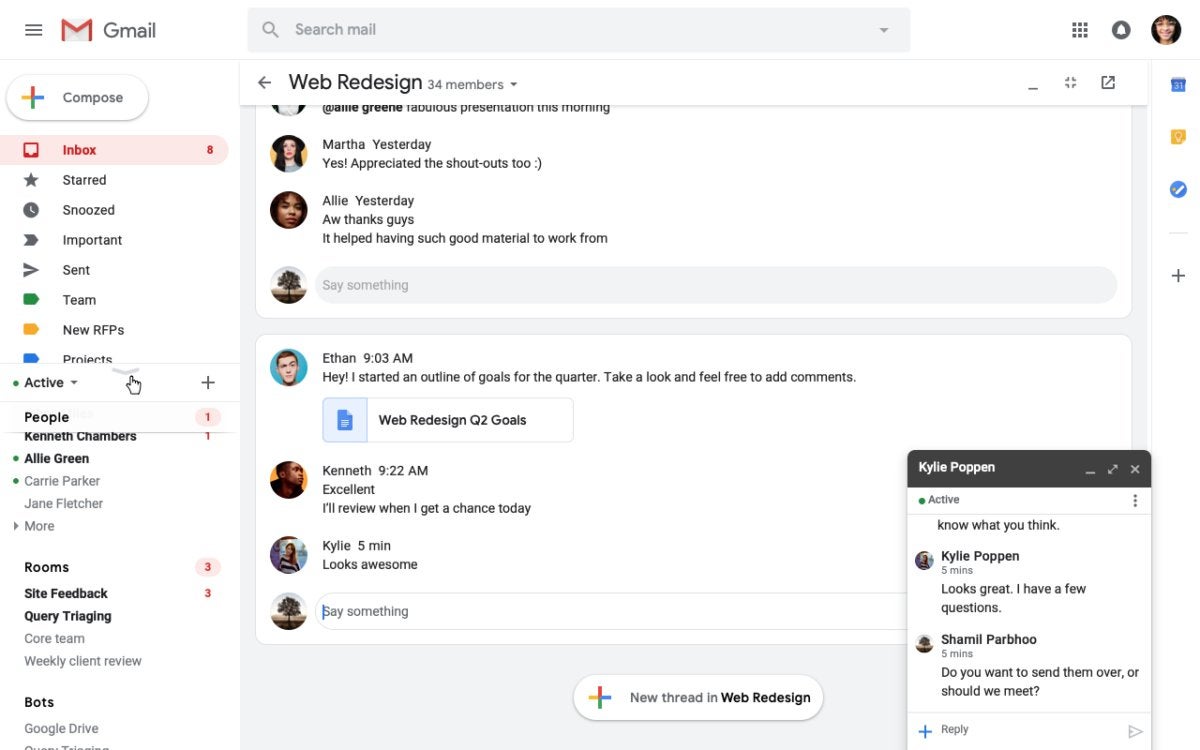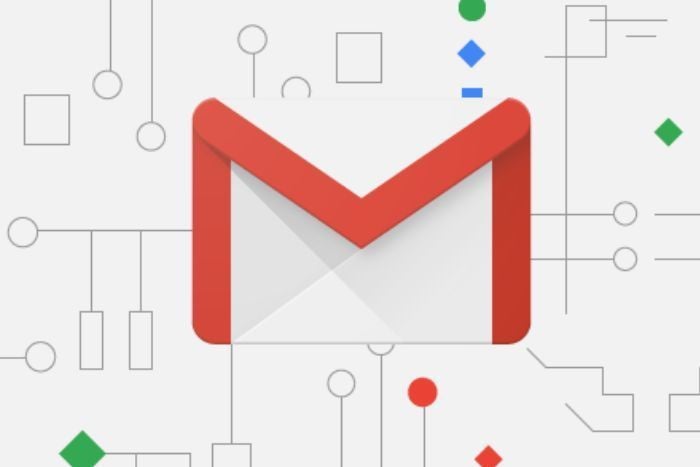As demand for team messaging apps continues to blossom, it may seem like email's days as the main business messaging tool are numbered. Google, however, sees the future of its team messaging tool, Hangouts Chat, as closely entwined with email.
The company laid outs its thinking at last month’s Google Cloud Next with a focus on the integration of Hangouts Chat into Gmail, which allows users to jump into Chat without switching apps.
The idea is that, like all software tools, real-time team chat has limitations as well as benefits. Ease of communication can lead to information overload, and quick-fire conversations can become distractions – the same problems still associated with email, issues team chat was supposed to fix.
Combining the two – chat and email – allows conversations to be pushed to the most fitting channel, said Google’s Jacob Bank, director of product management at G Suite. While team chat is great for ad-hoc discussions with colleagues, for example, email is better suited to more formal interactions.
“The premise of our communications strategy is that we are not going to live in a world where everyone abandons email and moves all of their communication to chat,” he said.
“Our basic approach is that chat is great for some use cases,” Bank said. “It’s fast, it’s informal, it’s low-anxiety, you can make decisions quickly – and it encourages transparency. It’s the digital water cooler where people feel more comfortable expressing themselves. But it can be interruptive, it can be distracting and it can be hard to extract signal from noise.
“Email, on the other hand, has a bunch of traditional strengths that in many ways are complementary to chat.”
Tying together Hangouts Chat and Gmail
Google first previewed Hangouts Chat in 2017, along with its video conferencing tool Hangouts Meet. (They were positioned as a replacement for the Hangouts tool within the company’s G Suite product portfolio.) Chat officially rolled out last year.
Launched amid a clamor for alternatives to the wildly popular Slack, there are a number of similarities between Google’s apps and its upstart rival. Hangouts Chat allows threaded message conversations in its group and direct messages, AI bots and a range of third-party integrations. A key strength: its integration with other G Suite apps such as Drive and Docs – and the company has added AI features such as Smart Reply over the last year.
While Bank said Google is making a “huge investment” in its team chat capabilities, Gmail will continue as the central communication “hub” for G Suite users. The Gmail integration reinforces that point, he said. It means users will be able to pull up a full-screen version chat tool directly from the left-hand column of the email client, without switching to the Hangouts Chat app. Previously, it was only possible to chat using a small direct-message pop-up within Gmail.
That allows users to quickly move from personal emails to group chat in a less disruptive way. Hangouts Chat will still be available as a standalone app.
Tim Banting, a principal analyst at Ovum, described the integration as a “good step forward” from a user perspective.
“We often hear how business messaging is replacing internal email; it makes sense to have it integrated within Gmail," Banting said. "Having a single client for collaboration and communications shows that Google is clearly thinking about ease of use. It’s not easy to design user interfaces that are uncomplicated and highly functional.”
Email…, not dead yet?
The integration highlights the company’s broader vision for employee communication and collaboration, said Bank. “The Hangouts Chat integration into Gmail signals a long-term ambition to blend the best of both worlds of traditional email inbox-based communication and team messaging,” he said.
“Gmail is the hub for our existing users today and we want to enrich that with more and more real-time functionality and more first- and third-party integrations. If there is a class of users that want to be chat primary, we will totally support that need as well.”
Google is not alone in recognizing the ongoing importance of email.
Microsoft Teams, for instance, is integrated with the developer's Outlook email client, alongside Office365. Slack, which expects channel-based communications to eventually become the dominant form of business communication, nevertheless partnered with both Google and Microsoft to bridge the gap with their email clients. And it plans to let users send messages from email directly into Slack channels and vice versa. For its part, Facebook last year acquired RedKix to help connect its Workplace social network with major email tools.
“Our long-term vision is a very deeply interconnected, intertwined experience that gets the value out of both channels,” Bank said. “We don't see it as a lightweight integration where you move an email conversation into a team chat, or publish the results of a team chat over email. But within a given a team you might be using email for its asynchronous and formal semantics, and chat for its synchronous informal semantics, both simultaneously as core parts of your workflow within the same experience.
“Everyone is realizing that email is not dead,” he said. “But I think we are embracing the benefits of email and the benefits of Gmail much more than anyone I have seen in the market.”
Cracking the team collaboration market
Google faces strong competition as demand for team collaboration tools continues to soar; its rivals have already attracted significant numbers of users. Slack has 10 million daily active users, including 85,000 paid business customers, while Microsoft Teams, which like Hangouts Chat is available as part of a suite subscriptions, is used in 500,000 organizations. Facebook’s Workplace has more than 30,000 paid organizations and about 2 million users in total.
It’s not clear how widely Hangouts Chat is actually used. The app is available as part of G Suite subscriptions, of which there are 5 million customers, but Google doesn’t break out stats for the messaging platform.
Google’s offering appears to lag behind others in the market. “Based on our volume of conversations with clients, there isn’t much customer momentum with Hangouts Chat,” said Larry Cannell, a research director at Gartner.
By integrating Hangouts Chat with Gmail, Google could spur greater adoption, said Angela Ashenden, a principal analyst at CCS Insight, providing an opening for adoption of the chat tool.
 Google
Google
Hangouts Chat in Gmail.
“Bringing Hangouts Chat into the Gmail user experience is a good way for Google to drive greater adoption of Hangouts Chat, blurring the lines between the two applications and reducing the context-switching needed as part of communication workflows,” she said.
“Right now, Gmail is the main center of gravity for the G Suite portfolio for most users, and so this is a low-friction way to introduce them to the capabilities of Hangouts Chat without leaving the comfort of Gmail,” Ashenden said.
Still, she noted that the integration move also “indicates that there is more they need to do to increase adoption” of the chat tool.
“In general there’s a need for better marketing and awareness about the different capabilities within G Suite, particularly outside the U.S.,” she said.
With a wide variety of collaboration options available, how does Google plan to stand out from its competitors and grow? Bank pointed to Hangouts Chat’s deep integration with G Suite apps.
A focus on productivity and minimal interruptions has been the major selling point of Gmail since its launch 15 years ago, he argued. This began with the introduction of spam detection, followed by features such as a priority inbox to separate social and promotional messages. The same approach can be applied to Hangouts Chat.
“It is not yet there, but we want to bring all of that technology to bear on the Hangouts Chat product, to reduce interruption, reduce distraction and help people feel confident that they're organized and not dropping the ball.”
Hangouts Chat updates
At Cloud Next, a number of new Chat features were announced. They include:
- Guest access for both Rooms and direct messages. Google noted that Rooms allowing external users to participate will be clearly marked.
- Further integrations between Chat and G Suite apps. This includes the ability to move from a one-to-one group text discussion to a Meet video call, as well as similar capabilities for phone calls with Google Voice.
- Out-of-office notifications will automatically be displayed before a message is composed, based on information provided from Google Calendar.
- Updates to Drive file-sharing permissions from within Chat will let users quickly offer file access to colleagues when sharing documents, rather than requiring them to request access separately. (It will also be possible to attach files from Team Drives into Hangouts Chat.)
- The existing Electron app for Hangouts Chat will be replaced with a progress web app based on the Google Chrome PWA architecture later this year. This means the app will be available on Linux and CrOS, as well as Mac and Windows.
Given the highly competitive market, Hangouts Chat has a way to go to match rival apps, analysts said.
“One significant missing feature is channels,” said Cannell. “While Hangouts Chat has Rooms, this is limited compared to how Slack and Microsoft Teams are able to organize chats.”
“It is disappointing that Hangouts Chat doesn’t integrate closer with Drive (especially Team Drives) and Docs,” he said. “After all, most teams need to work on content together.
“Microsoft Teams does a good job blending document collaboration with conversations due to Teams’ seamless integration with SharePoint and the Office apps," he said. "Slack’s integration with Google is impressive and arguably integrates closer with Google Docs than Hangouts Chat.”
Also announced at Cloud Next is a new Bot Catalog that lets users browse AI bots available to users within Hangouts Chat. The catalog also allows G Suite administrators to promote specific apps to their organization.
Focusing on automation should play to Google’s traditional strengths, said Ovum’s Banting. “I think where Google will excel is Bot capabilities and AI,” he said. “Google has a large network of developers that can utilize Google’s Chat Bot service to integrate with G Suite services and data.”
Ashenden said a focus on AI and automation could help move Hangouts Chat beyond chat and towards communications-driven process coordination. That would enable other applications and workflows to be woven into the team chat, she said.
“Google has made a solid start here with its bots features, but this is not yet a central part of the Hangouts Chat story – or the broader G Suite story, for that matter. Its competitors, Microsoft Teams and Slack, are focusing heavily here, and Google needs to build its capability and strategy in this area as well.
“It has many of the foundational pieces already, but it can certainly do more to articulate the opportunities for customers, developers and partners,” she said.






